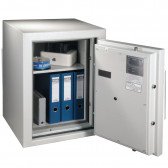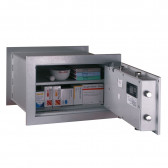The location of a safe is one of the most important aspects of having one in your house or flat. When choosing a safe, you will undoubtedly wonder where in your space it will fit best. Today, we'll try to approach this in a few ways and may be able to clear up your doubts.
Installation is important – further protect your new home safe from theft
The cruel truth about securing possessions is that any safe weighing less than 1,000 kg should be permanently mounted to the floor or wall. Otherwise, its security class will not be maintained despite being made to the correct norms and standards. Even a large safe that you set up, seemingly in a secured place, needs to be anchored.
The second reason for installing a safe is a purely practical argument. Free-standing safes with a high burglary and/or fire resistance rating will weigh their own weight, but a determined and equipped thief will undoubtedly attempt to take the safe to a secure location where he can break into the safe without pressure, and it is only a matter of time.
The installation of the safe is therefore, along with its security grade and weight, the third most essential piece of the jigsaw to ensure the comprehensive protection and security of your valuables or money.
Where to install a safe – or how to effectively hide a safe at home
The question "how to hide a safe?" comes up quite often. When choosing where to install the safe, you think about the fact that if you hide the safe, a thief will not find it. Contrary to what you may think, it is not easy to hide a safe in places that are not so obvious that it is actually effective.
The places where a safe can be installed are actually several in a house:
• in the bedroom,
• in the wardrobe,
• in the wardrobe in the hallway,
• in the study,
• in the storage space under the stairs,
• in the garage,
• in the basement,
• in the wall,
• in the floor.
All of these locations have their pros and cons; however, remember that wherever you decide to place the safe, the grade, weight and professional installation of the safe, rather than the location itself, will primarily determine your level of theft protection.
Security hygiene is also important. If you decide to install a safe in your home, keep this information for yourself and your household members. Outsiders should not even know that you want to place a safe in your house, and the information about what you will store in it and where the safe is installed should be a secret to outsiders in particular.
Where does a thief look most often?
Exactly where you do. A thief looks in places where he would hide a safe himself, so placing a safe in even the most finely tuned location is not 100 per cent certain to successfully hide a safe.
You can therefore be sure that any places in your home where you could hide a safe will be carefully checked: bedroom wardrobes, dressing room, study, basement or garage. Hiding a safe "for good and all" is in obvious contradiction to the everyday use of a safe. A safe in a house is mainly used to store weapons, documents, valuables and money, i.e. items that you want to have easy access to.
Installing a safe in the wall
Wall safes are such a popular topic that it is worth devoting a separate paragraph to them.
A wall safe differs from free-standing models. As a rule, it is a small safe – although wall safes can be of any size – which is characterised by concealed hinges that allow the front panel of the door to be covered by panels or a picture. Such a safe can be mounted at any height and flanked by a piece of furniture, such as a chest of drawers, or even placed inside a piece of furniture, in the lower parts of a wardrobe, etc.. Such safes are therefore concealed and not visible at first glance.
The wall safe is inserted into a pre-prepared recess in the supporting wall. If you are planning to buy a wall safe, you will need to choose a wall of a suitable thickness.
The opening angle of the door of the wall safe is limited to 90 degrees.
Read more: The wall safe – everything you need to know about it
Floor safe
A certain variation on the theme of safes designed to be invisible are floor safes. These units are embedded in the floor and poured with concrete all around, and the door is covered with panels so you can literally walk around the safe. It is a bit of a hassle to get inside it, but in this case concealment is the priority. The doors of floor-mounted safes open upwards thanks to pneumatic supports.
What can be stored in a home safe?
A home safe is designed to serve you, so you can store anything that is valuable to you. This could be important documents, valuables, family heirlooms, weapons or data carriers. Safes are designed to give you a sense of security when you are not at home. A safe at home, whether it contains documents or financially valuable items, is meant to give you comfort and help you in your everyday life.





